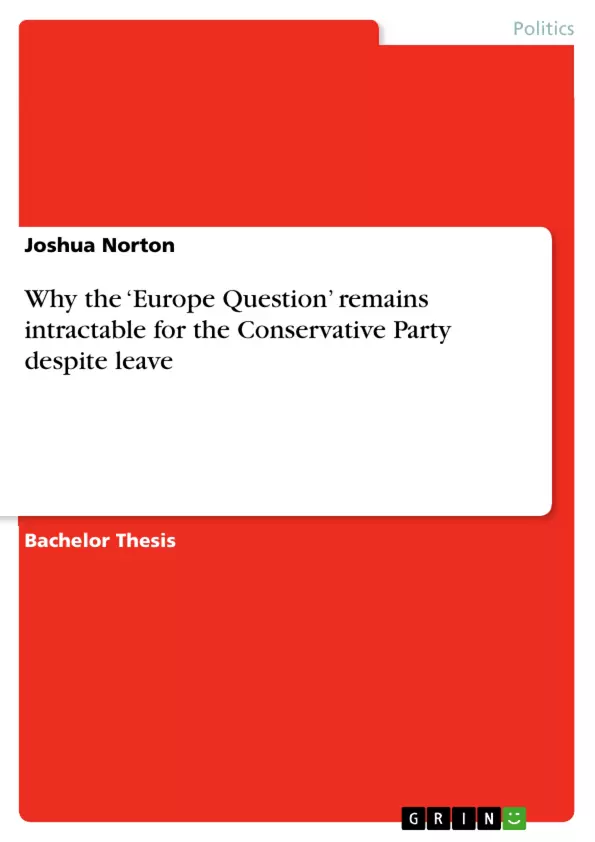The Maastricht Treaty of 1992 heralded an era of the intensification of European integration which served to amplify divisions within the Conservative Party. Using the case studies of John Major and David Cameron’s respective grapples with party division over Europe, this study looks at the intractability of the so-called ‘Europe Question’ for the Conservative Party. Policies of party management adopted by both Major and Cameron have proven to be unsuccessful, ultimately leading to an in/out referendum on the UK’s membership of the European Union which was won by the leave campaign on 23rd June 2016. This study argues that the divisions over the ‘Europe Question’ within the Conservative Party have become increasingly ideological and will therefore persist following the referendum in relation to the nature of the Brexit negotiations and the nature of the UK’s new relationship with Europe.
Inhaltsverzeichnis (Table of Contents)
- Introduction
- Literature Review
- Chapter One: The struggles of Maastricht
- EUROPE
- DOMESTIC
- PARTY
- Chapter Two: “Stop banging on about Europe”
- PARTY
- EUROPE
- DOMESTIC
- Chapter Three: Why the “Europe Question” has been intractable and the future
- CONSERVATISM AND EUROPE
- AFTER THE REFERENDUM
- Conclusion
Zielsetzung und Themenschwerpunkte (Objectives and Key Themes)
This study examines the Conservative Party’s long-standing struggles with the issue of the UK’s relationship with Europe, referred to as the ‘Europe Question.’ The study argues that this issue remains intractable despite the UK’s vote to leave the European Union in 2016. The work delves into the reasons behind this intractability, focusing on the Conservative Party's internal divisions and how these divisions have been exacerbated by the intensification of European integration.
- The Conservative Party’s divisions over Europe
- The influence of European integration on Conservative divisions
- The role of party management in addressing these divisions
- The persistence of the ‘Europe Question’ after the Brexit referendum
- The implications of these divisions for the Conservative Party and the UK
Zusammenfassung der Kapitel (Chapter Summaries)
- Introduction: This chapter introduces the research question, outlining the focus on the Conservative Party’s intractability with the ‘Europe Question’ and how the issue will persist despite the Brexit referendum. The chapter also presents the research methods and the key sources used in the study.
- Literature Review: This chapter examines the existing literature on Conservative attitudes towards Europe, particularly in relation to the Maastricht Treaty debates, David Cameron’s efforts to downplay the ‘Europe Question,’ and the ongoing divisions within the party over Brexit. It highlights the key sources and their contributions to the research.
- Chapter One: The struggles of Maastricht: This chapter explores the Conservative Party’s divisions over the Maastricht Treaty, analyzing how party management tactics, domestic politics, and European context contributed to the intractability of the ‘Europe Question’ during John Major’s premiership.
- Chapter Two: “Stop banging on about Europe”: This chapter examines David Cameron’s attempt to downplay the ‘Europe Question’ in the Conservative Party, illustrating how party management, European events, and domestic challenges ultimately led him to commit to a referendum on EU membership.
- Chapter Three: Why the “Europe Question” has been intractable and the future: This chapter delves into the reasons behind the Conservative Party’s persistent struggle with the ‘Europe Question,’ considering the party’s internal divisions, the influence of European integration, and the impact of the Brexit referendum. It argues that the ‘Europe Question’ will remain intractable and the divisions will shift to the context of negotiating the UK’s new relationship with the EU.
Schlüsselwörter (Keywords)
This study centers on the Conservative Party’s intractability with the ‘Europe Question,’ exploring the party’s divisions over European integration, the role of party management, the impact of the Brexit referendum, and the implications of these divisions for the UK’s future relationship with Europe. Key concepts include European integration, Euroscepticism, party management, Brexit, sovereignty, and Conservative dispositions. The study draws on the examples of John Major and David Cameron to analyze the ongoing challenges faced by the Conservative Party in navigating the issue of Europe.
- Quote paper
- Joshua Norton (Author), 2017, Why the ‘Europe Question’ remains intractable for the Conservative Party despite leave, Munich, GRIN Verlag, https://www.grin.com/document/431121



